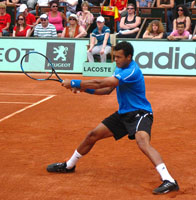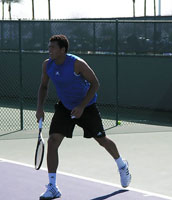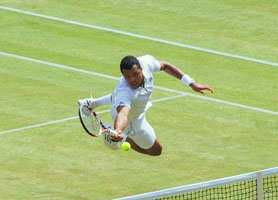 |
Born: April 17, 1985 Height: 1.88 m (6 ft 2 in) Birthplace: Le Mans, FranceResidence: Gingins, Switzerland Turned pro: 2004 Plays: Right-handed (one-handed & two-handed backhand) Career prize money: $ 68,314,141 Career titles: 71 Grand Slam results Website: www.jowilfriedtsonga.com |
Jo-Wilfried is a French professional tennis player. He was born in Le Mans, to a French mother, Évelyne, and a Congolese father, Didier, who moved to France in the 1970s to play handball.
Tsonga rose to fame by virtue of his performance in the 2008 Australian Open when, as an unseeded player, he reached the final, having defeated four seeded players along the way, including earning a straight sets win over the then world number two Rafael Nadal in the semifinals. Tsonga eventually lost to the then world no. 3 Novak Djokovic in the final in four sets, after winning the first set, the only set Djokovic dropped during the tournament.
Tsonga followed this up by winning his first ATP Masters Series championship at the 2008 Paris Masters, thus qualifying for the 2008 Tennis Masters Cup in Shanghai, China. His best performances in a major tournament since 2008 are semifinal appearances in the 2010 Australian Open and 2011 Wimbledon Championships. He also reached the final of the 2011 ATP World Tour Finals where he lost to five-time and defending champion Roger Federer.
Early and personal life
Jo-Wilfried Tsonga has a younger brother (Enzo) who, much like Jo, has been inspired to play sports and is part of the French basketball program (junior). He also has an elder sister (Sasha) who is less involved with sporting ventures. His football cousins are Charles N’Zogbia who currently plays for Aston Villa F.C and Maël Lépicier who plays for Congo. Tsonga and Gaël Monfils developed a good friendship from a young age, when they enjoyed mimicking all the tennis greats of the past.
As a junior, Tsonga reached a ranking of 69 and won the US Open title. He reached 3 other semi-finals of junior grand slam events. Marcos Baghdatis was a rival of Tsonga’s in the junior stage.
Tsonga had a successful junior career, winning the US Open Juniors title in 2003 by defeating Marcos Baghdatis in the final, and also reached the semifinals of the other three Grand Slam events.
After turning pro in 2004, Tsonga suffered a string of injuries beginning in late 2004, with a herniated disc that caused him to be out of action until March 2005. Then came two right shoulder injuries later in 2005, back and abdominal ailments from October 2005 to February 2006, and the recurrence of an abdominal injury at the end of 2006. In all, he played only eight tournaments during that time.
(Source: http://en.wikipedia.org/wiki/Jo-Wilfried_Tsonga)
 |
 |
 |
Playing style
Tsonga has an entertaining style of play, known for his effectively potent serves, as well as having powerful, heavy forehands and having great touch at the net. He has an offensive baseline style of play, but is also able to mix his style of play up by rushing to the net. He is also currently one of the very few remaining players who often utilizes a serve-and-volley type of play. Tsonga’s movement around the court is considered to be very good, considering his height. While he has a powerful repertoire of techniques, he has struggled to play consistently at important moments.
Tsonga’s serve is one of his most dominant shots, mixing both slice and speed, so enabling him to create and win easier points, such as an ace or a one-two-punch. Because of the action of his serve, which is dramatically abbreviated, he does very well to create as much power as he does, with speeds of up to 140 mph (225 km/h).
To date, Tsonga has achieved his best results on hard courts, most notably at the Australian Open, where he made the final in 2008, the quarter-final in 2009 and the semi-final in 2010 (the Australian Open plays a Plexicushion Prestige surface). In his career on the ATP circuit, the majority of his final appearances have come on hard courts. On grass, he reached the semi-finals at Wimbledon in 2011, and reached the final of the Queen’s Club Championships in 2011. In general, Tsonga has struggled on clay, although his clay-court skills are improving.
Tsonga is known for his aggressive groundstrokes. His forehand and backhand are both effective in setting up points. His powerful, heavy and accurate forehand is his most consistent shot, especially when delivered down the line. Although his backhand is generally not as strong as his forehand during the rallies, he is very capable of hitting attacking shots on his backhand wing. His net play is skillful, especially on attack. He often chooses to slice with great touch (especially on his backhand side), but does sometimes choose to deploy a drive volley. At times, he would often play a well-disguised drop shot to surprise his opponents during a rally. He can play both two-handed and one-handed backhand. He added the one-handed backhand into his repertoire midway through 2011; evident in his matches against Murray in the final of Queen’s Club and against Federer in the quarter-finals of Wimbledon. Although rarely used as a groundstroke in a neutral rally, it is particularly effective as a passing shot down the line or cross-court.
(Source: http://en.wikipedia.org/wiki/Jo-Wilfried_Tsonga)
http://youtu.be/7uvdpkoCiGk
